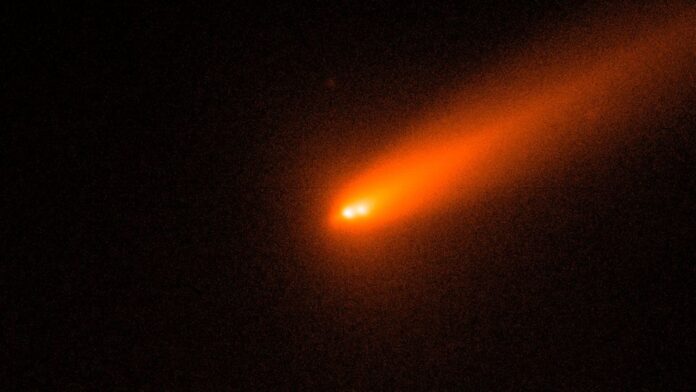Astronomers have documented the dramatic breakup of comet C/2025 K1 (ATLAS), which split into three distinct fragments following a close approach to the sun in early October. The event, captured by telescopes in Italy on November 11-13, provides a rare glimpse into the fragile nature of cometary nuclei.
Cometary Behavior and Fragmentation
Comet C/2025 K1 (ATLAS) was discovered in May 2025 and exhibited increasing brightness as it neared the sun. The comet’s core, composed of frozen gases, heated up, forming a reflective coma and a characteristic tail pushed by solar wind. Despite not becoming visible to the naked eye, the comet’s structural integrity was compromised during its October 8 solar encounter.
Observations from the 1.82m Copernicus telescope at the Asiago Observatory revealed the fragmentation by November 11. Astronomer Mazzotta Epifani confirmed two large fragments separated by roughly 2,000 kilometers, with a possible third, smaller fragment also present. Subsequent imaging by Gianluca Masi of the Virtual Telescope Project on November 12-13 showcased a significant portion of the nucleus breaking away from the sun-facing side.
Significance of the Breakup
The fragmentation of C/2025 K1 (ATLAS) is not uncommon for comets making their first journey into the inner solar system. The intense heat and gravitational forces can destabilize these ancient, loosely bound bodies. This event offers a unique opportunity to study the composition of a pristine cometary nucleus, potentially shedding light on the early solar system and the formation of planets.
Distinguishing C/2025 K1 (ATLAS) from Other Comets
It is important to differentiate C/2025 K1 (ATLAS) from the interstellar comet 3I/ATLAS, which recently gained attention due to its unusual color shifts and unfounded conspiracy theories linking it to extraterrestrial spacecraft. Both comets share the “ATLAS” designation because they were discovered by the Asteroid Terrestrial-Impact Last Alert System (ATLAS) program.
Observing Distant Comets
Photographers and astronomy enthusiasts interested in capturing their own images of distant comets can explore resources on smart telescopes, cameras, and astrophotography techniques. The breakup of C/2025 K1 (ATLAS) serves as a reminder of the dynamic and often unpredictable nature of celestial objects in our solar system.
The fragmentation of C/2025 K1 (ATLAS) provides a rare opportunity to study the composition of a pristine cometary nucleus, shedding light on the early solar system and the formation of planets. The event underscores the dynamic nature of celestial bodies and the unpredictable forces at play in our solar system
